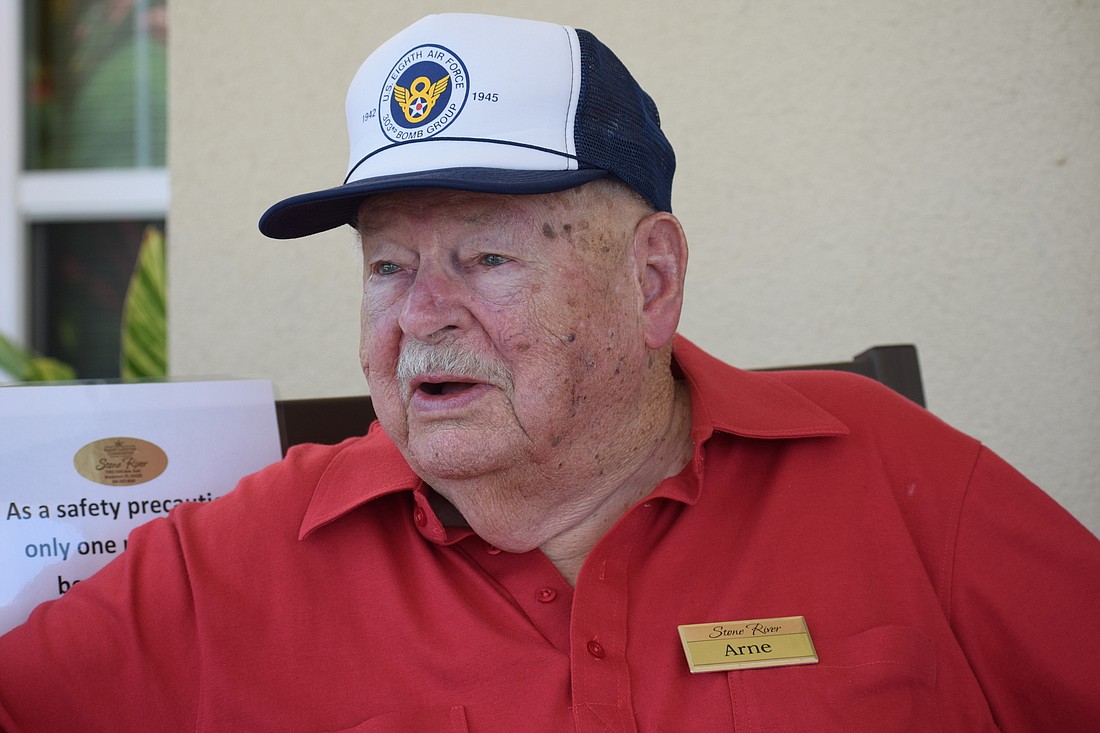- December 12, 2025
-
-
Loading

Loading

Imagine dressing for work if you were one of nine crew members like East County's Arne Hansen aboard a B-17 bomber headed from England toward Berlin, and hopefully back, during World War II.
First would come the insulated suit since high altitude bombing at 30,000 feet often meant conditions inside the aircraft would be between -30 and -60 degrees.
Then came the uniform because if the plane went down and you survived, you needed to be identified as a member of the U.S. Army Air Corps.
Next came a flak suit needed to prevent the high explosive weaponry being shot at the plane from piercing your body.
The final full layer included more cold-weather apparel to prevent you from freezing.
Oh, and your outer wear had a couple of hooks so you could attach your parachute to it. Just in case.
Now living at the Stone River Retirement Community, Hansen spent time May 13 — the day following his 95th birthday — talking about his role as a bombardier in the 303rd Bomb Group of the U.S. Eighth Air Force. He agreed to share his memories in observance of Memorial Day (May 25).
Hansen experienced the meaning of Memorial Day first hand when his crew's co-pilot, Jim Workersen, was killed by flak during a bombing mission to Berlin in 1945. Their B-17 was flying through heavy flak when Workersen was hit 2 minutes before the crew released bombs over the target ... rail yards.
It was a horrifying moment even through Hansen said it was "a flip of the coin whether I would be alive or dead" each of his 12 missions. After one mission, those patching the plane counted more than 200 holes.
His wife of five years, Dee, listened along with Hansen's son-in-law, Polo Run's Thomas Thomas Tollette (married to Hansen's daughter Chris), as the former bombardier told the stories.
"To me, he is a hero," Dee Hansen said. "I'm amazed by the stories ... these young men capable of going into this adventure knowing they might not come back. They did it without question. It was an honor.
"He's a man of history."
Hansen's history as a soldier began when he enlisted in the U.S. Army Air Corps shortly after he graduated from Staten Island, N.Y.'s Curtis High School in 1943.
"Just about all the boys were going to be called up," he said of his fellow Curtis High seniors. "We wanted to enlist so we could have a choice where we wanted to go. My brother, Helmer, who was 5 years older, already was in (the Air Corps). He was a ground guy, an upper turret sight specialist."
After enlisting, Hansen was shocked to find out he would be shipped to basic training within weeks. His parents, Hans and Agnes, were immigrants from Norway. Hans was a finish carpenter who worked on the Empire State Building. To this day, Arne Hansen, a native New Yorker, never has been to the Empire State Building.
Hansen went to basic training and then took 6 months of college studies at Duquesne University in Pittsburgh as part of the pilot's program. It was there he flew for the first time, loving it right away. After the college study was completed, it was off to Maxwell Field in Montgomery, Ala. He said more than 80,000 troops were training there and the officers were strictly business. For example, at 2 a.m. one night, more than 40,000 troops were lined up on the grounds because one of the trainees had cheated on a test and was being expelled from the program. In wartime, that kind of behavior wasn't going to be tolerated.
His dreams of being a pilot were dashed when he was sent to Demming, N.M. to learn the intricacies of the Norden bombsight. Bombardiers had to learn the top-secret Norden bombsight, a tachometric design that revolutionized high-altitude bombing. With allied soldiers marching into Germany, the accuracy was imperative so bombardiers didn't hit their own soldiers.
In February, 1945, Hansen arrived in Molesworth, England, where he joined the 303 Bomb Group, which the soldiers called the "Hell's Angels." It was only days before he was sent on his first mission. All his missions were completed in the next three months.
His role as a bombardier troubled Hansen, but he knew it was his duty. When Workersen was killed, he admits dropping bombs didn't bother him as much, although he did switch to a navigator's role in his last three missions.
He became familiar with the fine line between life and death. On one mission, a 1,000-pound bomb stuck in the chute as it was being released.
"It was stuck at a 45-degree angle and the fuse was hot," he said. "I had to take a screwdriver and manually release a hook it was caught on. The whole time I was thinking, 'Don't drop the screwdriver,' because we didn't have another one. I got it, and we dropped it over the English Channel."
On another mission, his plane lost two engines on the left wing but landed safely.
"I was lucky enough to fly on airplanes that always came back," he said. "But it was scary as Hell."
After the Germans surrendered, Hansen was sent back to the U.S. He remained a soldier for the next 20 years before retiring as a major. After owning his own heating equipment company in Appleton Wisc., he eventually moved to Florida in 1990. He did earn his pilot's license in 1956.
All along the way, he has had nightmares over the years, reliving entire flights.
On one flight, flak exploded in a red glare that enveloped his plane.
"I thought I was dead," he said.
Somehow, he made it through.